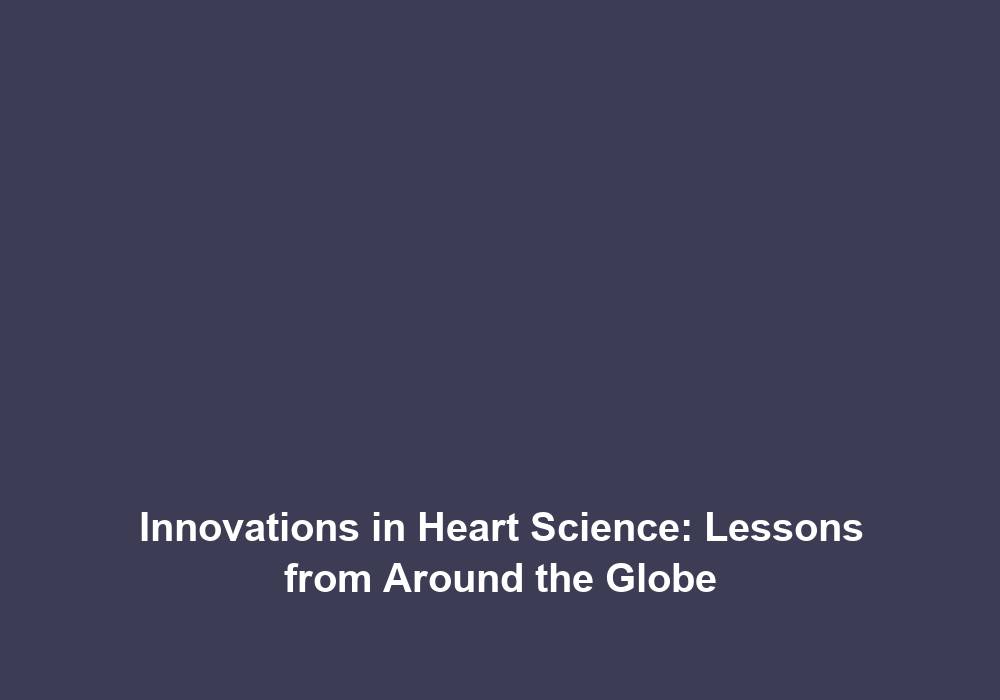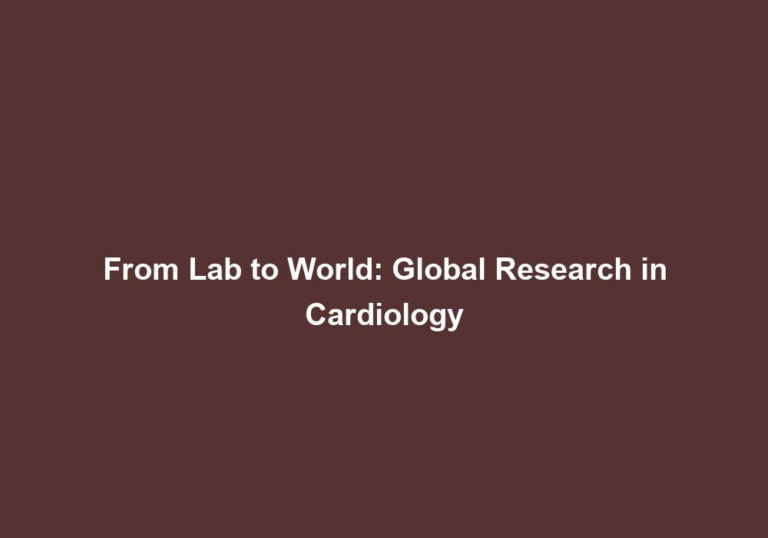Innovations in Heart Science: Lessons from Around the Globe
Heart disease continues to be a leading cause of mortality worldwide, with millions of lives affected by its various forms. However, thanks to groundbreaking innovations in heart science, researchers and medical professionals are making significant strides in understanding, preventing, and treating heart conditions. In this article, we will explore some of the remarkable advancements in heart science from around the globe, highlighting the valuable lessons they offer.
1. Precision Medicine: Personalized Approaches to Cardiac Care
In recent years, precision medicine has emerged as a game-changer in the field of heart science. This approach involves tailoring medical treatments and interventions to an individual’s specific genetic makeup, lifestyle, and environmental factors. By analyzing a patient’s unique characteristics, doctors can develop personalized strategies for prevention, diagnosis, and treatment of heart diseases.
Some key aspects of precision medicine in cardiovascular care include:
- Genetic Testing: Genetic testing plays a crucial role in precision medicine. By identifying genetic markers and mutations that increase the risk of developing heart conditions, healthcare professionals can implement targeted interventions and early detection strategies. This allows for more effective prevention and treatment plans.
- Pharmacogenomics: Understanding how an individual’s genetic profile affects their response to medications is vital in optimizing treatment plans. Pharmacogenomics helps identify which medications are most suitable for a patient based on their genetic makeup, reducing the risk of adverse reactions and improving overall treatment outcomes.
- Lifestyle Modification: Precision medicine takes into account various lifestyle factors that contribute to heart disease, such as diet, physical activity, and stress management. By considering these factors, healthcare providers can offer personalized recommendations to reduce the risk of heart disease. This may include dietary changes, exercise plans, and stress reduction techniques tailored to each individual.
2. Transcatheter Aortic Valve Replacement (TAVR)
Traditionally, valve replacement surgeries required open-heart procedures, which carried significant risks and lengthy recovery periods. However, the development of Transcatheter Aortic Valve Replacement (TAVR) has revolutionized the treatment of aortic valve stenosis.
TAVR involves the insertion of a collapsible artificial valve into the heart via a catheter, typically through a small incision in the groin or chest. This minimally invasive procedure provides a safe and effective alternative for high-risk patients who may not be suitable candidates for open-heart surgery. TAVR has significantly reduced mortality rates, hospital stays, and recovery times, offering renewed hope to those diagnosed with aortic valve stenosis.
The benefits of TAVR include:
- Reduced Risks: Compared to traditional open-heart surgeries, TAVR carries fewer risks, such as infection and bleeding. The minimally invasive nature of TAVR also leads to smaller incisions and less trauma to the patient’s body.
- Shorter Recovery Times: Patients who undergo TAVR typically experience shorter hospital stays and faster recovery times compared to open-heart surgery. This allows individuals to resume their normal activities sooner, improving their overall quality of life.
- Expanded Treatment Options: TAVR provides a treatment option for patients who were previously considered high-risk or ineligible for open-heart surgery. This breakthrough has expanded treatment possibilities, giving hope to individuals who may have had limited options in the past.
3. Artificial Intelligence (AI) in Cardiovascular Care
Artificial intelligence has made significant inroads into the field of cardiovascular medicine, transforming the way heart diseases are diagnosed, monitored, and treated. By leveraging machine learning algorithms and big data analysis, AI can process vast amounts of patient data to identify patterns, predict outcomes, and recommend personalized treatment plans.
Some notable applications of AI in heart science include:
- Image Analysis: AI algorithms can accurately interpret complex medical images such as cardiac MRI and CT scans, facilitating early detection and precise diagnoses. This allows healthcare professionals to identify and analyze subtle abnormalities that may not be easily detectable by human observers.
- Risk Stratification: AI has the ability to analyze large datasets and identify patterns that can predict the likelihood of an individual developing cardiovascular diseases. By considering various risk factors, AI can provide proactive interventions and preventive measures, enabling early detection and management of heart conditions.
- Remote Monitoring: AI-powered wearable devices and smartphone applications allow real-time monitoring of vital signs, such as heart rate and blood pressure. This continuous monitoring enables timely detection of abnormalities and prompt medical intervention, potentially preventing serious cardiac events.
4. 3D Printing in Cardiac Surgery
The advent of 3D printing technology has opened up new possibilities in cardiac surgery, particularly in the creation of patient-specific cardiac models and surgical tools. By utilizing high-resolution imaging techniques, surgeons can generate accurate 3D models of a patient’s heart, allowing for preoperative planning and simulation of complex procedures.
Some benefits of 3D printing in cardiac surgery include:
- Enhanced Surgical Precision: 3D-printed models enable surgeons to visualize intricate structures and plan surgical interventions with precision, reducing the risk of errors during procedures. This visualization aids in optimizing surgical outcomes and improving patient safety.
- Training and Education: Medical students and resident physicians can practice procedures on lifelike 3D models, improving their technical skills and surgical outcomes. This hands-on training enhances their understanding of cardiac anatomy and prepares them for real-life surgical scenarios.
- Customized Implants: 3D printing allows for the creation of patient-specific implants and devices. Surgeons can design and fabricate personalized implants that fit perfectly, increasing the likelihood of successful surgeries and reducing postoperative complications. This customization also improves patient satisfaction and long-term outcomes.
Conclusion
The field of heart science continues to witness remarkable innovations from different corners of the globe. Precision medicine, TAVR, AI, and 3D printing are just a few examples of how groundbreaking advancements are improving cardiac care. By embracing these lessons and integrating them into healthcare systems worldwide, we can strive towards a future where heart disease is better understood, prevented, and treated, ultimately saving countless lives.







